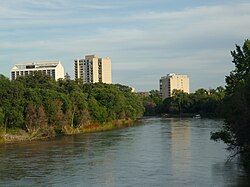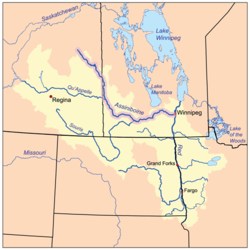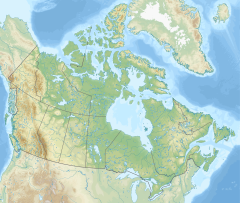| Assiniboine River | |
|---|---|
 A view of the Assiniboine River looking southeast from the Maryland Bridge in Winnipeg | |
 Red River drainage basin, with the Assiniboine River highlighted | |
| Location | |
| Country | |
| Provinces | |
| Physical characteristics | |
| Source | Windy Lake east of Kelvington |
| • location | Saskatchewan |
| • coordinates | 52°18′15″N 103°06′01″W / 52.30417°N 103.10028°W |
| • elevation | 640 m (2,100 ft) |
| Mouth | Red River of the North |
• location | The Forks in Winnipeg, Manitoba |
• coordinates | 49°53′09″N 97°07′44″W / 49.88583°N 97.12889°W |
• elevation | 230 m (750 ft) |
| Length | 1,070 km (660 mi) |
| Basin size | 182,000 km2 (70,000 sq mi) |
| Discharge | |
| • average | 45 m3/s (1,600 cu ft/s) |
| Basin features | |
| River system | Red River |
| [1][2] | |
The Assiniboine River (/əˈsɪnɪbɔɪn/ ə-SIN-ih-boyn; French: Rivière Assiniboine)[3] is a 1,070-kilometre (660 mi) long river that runs through the prairies of Western Canada in Saskatchewan and Manitoba. It is a tributary of the Red River. The Assiniboine is a typical meandering river with a single main channel embanked within a flat, shallow valley in some places and a steep valley in others. Its main tributaries are the Qu'Appelle, Souris, and Whitesand Rivers.
The river takes its name from the Assiniboine First Nation. Robert Douglas of the Geographical Board of Canada (1933) made several comments as to its origin: "The name commemorates the Assiniboine natives called by La Vérendrye in 1730 'Assiniboils' and by Governor Knight in 1715 of the Hudson's Bay Company 'stone Indians.' Assiniboine is the name of an Indian tribe and is derived from 'assine' a stone and 'bwan' native name of the Sioux, hence Stony Sioux name was possibly given because they used heated stones in cooking their food."[4]
- ^ "Natural Resources Canada-Canadian Geographical Names (Assiniboine River)". Retrieved 29 August 2014.
- ^ "Atlas of Canada Toporama". Retrieved 29 August 2014.
- ^ "Rivière Assiniboine". Termium Plus. Public Works and Government Services Canada. 8 October 2009. Retrieved 3 September 2020.
- ^ R. Douglas, Place names of Manitoba, Geographic Board of Canada, Department of Interior, Canada, 1933

